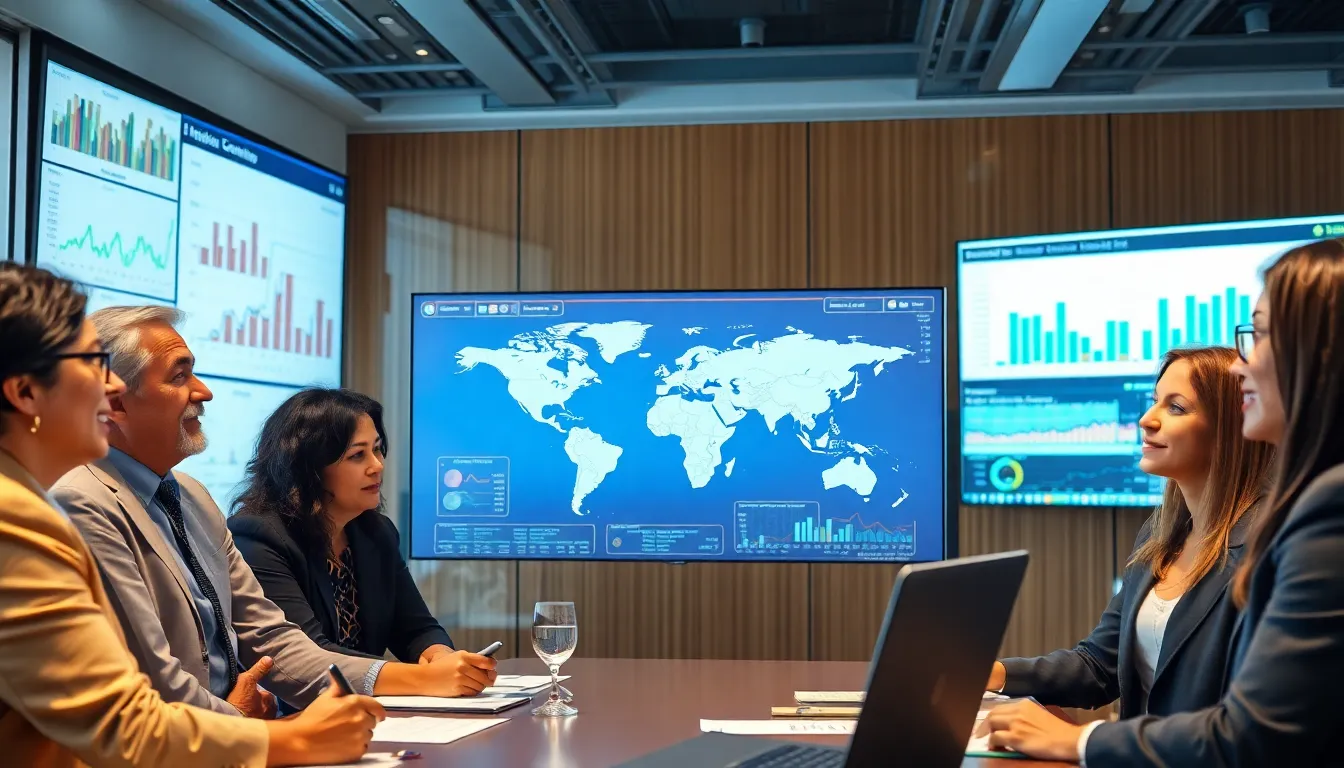Table of Contents
ToggleIn an increasingly interconnected world, the dynamics of the global economy shape lives and livelihoods across continents. Understanding the world economy isn’t just for economists; it’s essential for anyone who wants to grasp the forces that drive trade, investment, and growth. From emerging markets to developed nations, every economy plays a crucial role in this intricate web.
As nations navigate challenges like inflation, supply chain disruptions, and shifting consumer behavior, the implications are far-reaching. The world economy influences everything from job markets to technological advancements. By examining these trends, one can gain valuable insights into the future of global commerce and the opportunities that lie ahead.
Overview of the World Economy
The world economy comprises interconnected national economies that engage in trade, investment, and finance. It encompasses diverse markets, including advanced economies like the United States and emerging markets in regions such as Asia and Africa. Global economic activities influence local developments, making it crucial for stakeholders to monitor trends and shifts.
Various factors contribute to the health of the world economy, including growth rates, employment levels, and currency stability. Economic growth rates vary widely; for instance, the International Monetary Fund (IMF) projected a global growth rate of 3.5% for 2023, down from 6% in 2021. These fluctuations result from market demands, fiscal policies, and geopolitical events.
Trade relationships form the backbone of global commerce. In 2022, global merchandise trade volume increased by 9.7%, according to the World Trade Organization (WTO). Major trading partners, such as the U.S., China, and the European Union, exhibit substantial trade flows that impact economies worldwide.
Inflation presents a critical challenge for the world economy. Recent data indicates that inflation rates surged to 8.3% in the U.S. in 2022, driven by higher energy prices and supply chain disruptions. Such spikes affect purchasing power and economic stability across nations.
Supply chain disruptions caused by factors such as the COVID-19 pandemic have reshaped production and distribution networks. Companies are adapting by diversifying suppliers and increasing inventory levels to mitigate risks. These changes indicate a significant transformation in how global trade operates, revealing vulnerabilities and opportunities for innovation.
Understanding these dynamics helps individuals and businesses navigate the complexities of the world economy. Awareness of market conditions, trade relationships, and economic indicators can facilitate informed decision-making and strategic planning.
Key Factors Influencing the World Economy

Understanding key factors that influence the world economy helps individuals and businesses make informed decisions. Multiple elements interact to shape global economic conditions, each playing a critical role in driving growth and stability.
Global Trade Dynamics
Global trade dynamics encompass the exchange of goods and services across national borders, impacting economic growth and relationships. In 2022, global merchandise trade volume increased by 9.7%, underscoring the importance of trade for economic development. Trade agreements, tariffs, and trade barriers significantly influence exports and imports, while evolving supply chains adapt to geopolitical tensions, such as trade disputes or sanctions. The interplay of consumer demand and producer supply shapes trade patterns, creating opportunities and challenges for countries at various development stages.
Technological Advancements
Technological advancements drive innovation and efficiency across industries, influencing economic growth. Digital technologies, including artificial intelligence and blockchain, revolutionize production processes, enhance service delivery, and create new markets. In 2020, investments in fintech reached $105 billion, highlighting the sector’s growth and its impact on global finance. The rapid adoption of automation and remote work technologies, accelerated by the COVID-19 pandemic, reshapes labor markets and increases productivity while requiring reskilling of the workforce to meet new demands.
Political Stability
Political stability significantly affects economic performance, influencing investor confidence and national growth trajectories. Countries with stable governments attract foreign direct investment, contributing to job creation and infrastructure development. On the other hand, political unrest or corruption can deter investment, disrupt markets, and hinder economic progress. For instance, a study indicates that countries experiencing political instability see a reduction in GDP growth rates, contrasting with nations that maintain stable governance and equitable policies. Political factors, such as policy changes and international relations, play a crucial role in shaping the global economic landscape.
Current Trends in the World Economy
Current trends reveal significant shifts in the world economy, shaped by global events, market dynamics, and policy responses. Understanding these trends is crucial for navigating the interconnected economic landscape.
Emerging Markets
Emerging markets play a pivotal role in the current world economy, exhibiting robust growth rates compared to developed nations. Countries such as India, Brazil, and Vietnam show increasing investment opportunities, with GDP growth rates surpassing 6% in 2023. Foreign direct investment (FDI) in these regions reached approximately $470 billion in 2022, illustrating heightened global interest. Furthermore, digital transformation initiatives in emerging markets drive innovation and create new consumer bases, facilitating trade and economic expansion. Currency stabilization efforts are also vital, as countries work to manage inflation and enhance investor confidence.
Economic Recovery Post-Pandemic
Economic recovery post-pandemic unfolds unevenly across the globe. Advanced economies see gradual resurgence, with the International Monetary Fund (IMF) predicting growth of 2.4% for industrialized nations in 2023. In contrast, developing economies exhibit stronger rebounds, fueled by increased domestic demand and improved vaccination rates. Employment levels in sectors like technology and healthcare return to pre-pandemic conditions in many regions, although other sectors lag. Governments implement targeted fiscal policies and stimulus packages, aiming to sustain growth and support vulnerable populations. Supply chain resilience remains a focus, as businesses continue to adapt, implementing strategies to mitigate future disruptions.
Challenges Facing the World Economy
Global economic challenges impact growth, stability, and the quality of life for people worldwide. Key issues include inflation, the rising cost of living, and supply chain disruptions.
Inflation and Cost of Living
Inflation poses a significant threat to the world economy, affecting purchasing power and overall economic stability. In the United States, inflation rates soared to 8.3% in 2022, largely due to escalating energy prices and supply chain issues. Rising costs of essential goods and services strain household budgets, leading to decreased consumer spending. Countries across Europe and Asia confront similar inflationary pressures, causing central banks to adjust interest rates to combat rising prices. These adjustments often slow economic growth and impact investment decisions.
Supply Chain Disruptions
Supply chain disruptions create severe challenges for global trade and production. The COVID-19 pandemic exposed vulnerabilities in existing supply chains, resulting in delays and increased costs for many industries. Companies experienced shortages in raw materials, leading to declines in production efficiency. A reported 9.7% increase in global merchandise trade volume in 2022 implies a recovery; however, persistent disruptions hinder stability. Businesses adapt by diversifying supply sources and enhancing inventory management to mitigate future risks. Political factors, such as geopolitical tensions and trade policies, also contribute to ongoing supply chain challenges.
Future Outlook for the World Economy
The future of the world economy reflects ongoing trends and emerging challenges. Analysts predict shifts in growth dynamics, influenced by multiple factors including technological advancements and geopolitical events.
Predictions and Projections
The International Monetary Fund (IMF) forecasts a global growth rate of approximately 3% for 2024, indicating stabilized recovery but slower than pre-pandemic levels. Emerging economies are expected to outpace developed nations, with growth projections of 4-5% in regions like Asia and Africa. Interest rates from central banks are likely to remain elevated until inflation declines consistently. Significant volatility may occur due to geopolitical tensions, impacting global trade. Supply chain adaptations may lead to reshoring, aligning production closer to consumer markets. Climate change initiatives might drive substantial investment in renewable energy, offering new avenues for economic growth.
Opportunities for Growth
Opportunities for growth within the world economy may arise from sectoral shifts and technological advancements. The digital transition is expected to continue, contributing to a projected $23 trillion digital economy by 2025. Sustainable industries, including clean energy and electric vehicles, are poised for expansion, with global investments in renewables expected to exceed $1 trillion annually. The rising middle class in emerging markets may enhance demand for various goods and services, creating potential markets for international businesses. Additionally, advancements in artificial intelligence and automation can improve productivity, fostering competitive advantages in various sectors. Collaboration on trade agreements could enhance access to new markets and stimulate economic interactions. Emerging technologies are likely to redefine economic landscapes, presenting significant opportunities for innovation and market growth.
The current landscape of the world economy presents both challenges and opportunities. As nations navigate inflation and supply chain disruptions, the interconnectedness of global markets becomes increasingly evident. Emerging economies are poised for growth, driven by a rising middle class and technological advancements.
Investors and policymakers must remain agile, adapting to shifting dynamics and leveraging opportunities in sectors like digital technology and sustainable industries. Understanding these trends is crucial for making informed decisions in an ever-evolving economic environment. The future of the world economy will depend on how effectively countries collaborate and innovate in response to both challenges and emerging possibilities.





